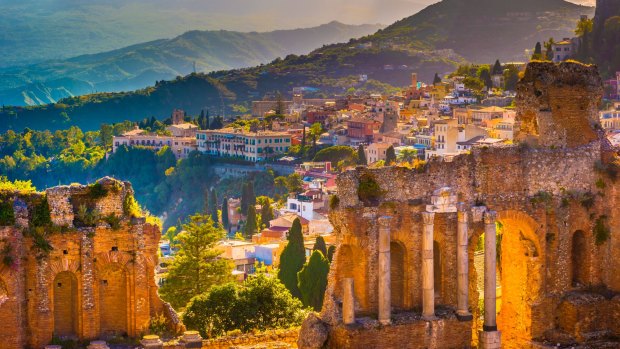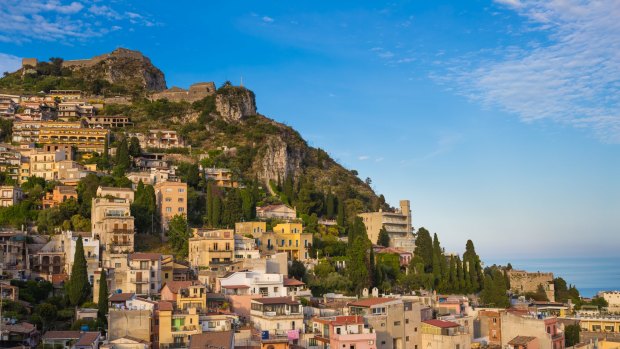This was published 5 years ago
Italy, Sicily: Tour southern Italy's stunning cuisine-rich island framed by Mount Etna

The ruins of Taormina theatre in Sicily.Credit: Shutterstock
"Salvatore is a very experienced driver, you can tell by the colour of his hair," says Vincenzo, our jovial, wise-cracking (and follicly challenged) tour manager, as his snow-white-haired colleague expertly navigates our coach along a steep, bending highway that takes us deeper into the disarmingly pretty Sicilian countryside.
Mountainsides are quilted in a patchwork of vineyards, orchards, villas, farmhouses and fields of wheat that hark back to the ancient Romans, one of myriad civilisations to have ruled this, the largest – and arguably most engrossing – of the Mediterranean islands.
"Sicily was known as the granary of the Roman Empire," says Vincenzo. "It used to be covered in forests, but the Romans chopped everything down so they could grow wheat to feed their armies, and use the timber to build homes and ships. The lemon and olive trees we see now were imported more recently from other Mediterranean countries like Lebanon."

The picturesque town of Taormina.Credit: Shutterstock
I snap out of a trance, brought on by this captivating scenery, when Salvatore pulls into Agriturismo Case Varisco. It's a family-owned farm converted into a retreat that offers travellers a rustic slice of Sicily, whose major tourist sights – and 5 million people – are mostly located by the coast. We're welcomed by the vivacious Cinzia, who leads us to a sun-kissed, flower-fringed terrace for prosecco and antipasti that includes bread drizzled with olive oil, artichokes, chutneys and caponata, a sweet and sour Sicilian vegetable dish of eggplant, celery, capers and olives.
This being Sicily, there's also ricotta to be had. Whether it's hidden in salads, melted on penne, or sweetened and wedged into fried pastry tubes for cannoli, this whey cheese features in almost every meal. Cinzia guides us into a shed where farm worker Ciccio is hand-crafting ricotta, like he does every day, after milking the farm's 150 sheep. As he stirs a pole through the heated liquid in a steel vat, Cinzia talks us through the production process in her endearing, Italian-accented English. Then she feeds us warm, creamy samples of the freshest ricotta you could ever hope to taste.
Another Sicilian staple that I eat a lot of during our trip is arancini. Using ingredients prepared in the dining room by head chef, Giovanni, myself and four other gents are tasked with making 50 of these stuffed rice balls in five minutes. Cheered on by the others in our group, we do it in four, rolling the balls together with bechamel, saffron, ham, cheese, rice, flour and breadcrumbs. Deep-fried, the arancini reappear as part of a wine-fuelled, multi-course lunch that lasts the best part of two hours, giving us time to mingle and admire the idyllic scenery through the restaurant windows. There are about 30 of us on this trip from places as varied as Boston and Sydney, Vancouver and London, and many have Sicilian roots, their relatives having emigrated in the 19th and 20th centuries.
After dessert, which includes some of the biggest cannoli I've seen, Cinzia regales us with tales of life, love and family in rural Sicily before Sophia, her 10-year-old daughter, pours us shots of limoncello and amaro (a herbal liqueur) and hands us gift-wrapped biscuits to take home. Sophia's English is already better than my Italian, and we see why when Cinzia shows us a wall display with pictures of everyday items next to English words and phrases.
Amid a frenzy of hugs, cheek kisses and "mille grazies", we bid a fond farewell to Cinzia and, buoyed by this lovely afternoon, hop back on the coach to Palermo, where we're based for the first four nights of our trip. It's the vibrant, rejuvenated, market-crammed capital of an island that, while just three kilometres from mainland Italy at its narrowest point, is dubbed "the continent" by independent-minded Sicilians.
Sicily only became part of a unified Italy in 1860 and, as such, its culture, language, food, drink and DNA have been shaped by a fusion of Mediterranean influences. We learn more about this melting pot from Vincenzo and the other local guides who join us along our Sicilian journey, which reveals a beguiling mix of UNESCO World Heritage sites and hidden gems.
For our last four nights on Collette's nine-day Splendid Sicilia tour, we swap the north coast for the east, checking into Hotel Villa Diodoro, an elegant retreat overlooking the Ionian Sea in Taormina, a postcard-perfect clifftop town that has been around since well before Christ, but was "rediscovered" in the late 18th century after Johann Wolfgang von Goethe passed through and waxed lyrical about it.
Other famous writers, notably D. H. Lawrence, Oscar Wilde and Tennessee Williams, followed suit, as did royals, emperors and Hollywood stars. Celebrities are still regularly spotted with the likes of Sting, Bob Dylan and Madonna performing at Taormina's breathtaking open-air theatre, which we're lucky to have virtually to ourselves on our early-morning tour. Built by the ancient Greeks, the theatre was modified by the Romans and restored after World War II. Last year it welcomed global leaders for a G7 summit.
The biggest presence in and around Taormina, however, is Mount Etna. Depending on the weather – and it's changeable during our mid-October trip, with mostly warm, sunny days interspersed with overcast conditions and occasional downpours – we see this mighty, snow-capped 3327 metre peak from our bedroom balconies. Not just Europe's highest volcano, it's also one of its most active. Eruptions of steam, ash and lava aren't uncommon, though everything is reassuringly sedate when Salvatore drives us up Etna's narrow, zig-zagging roads for lunch and wine tasting at Tenuta San Michele, one of the wineries on its lower slopes.
Almost 1 million people live on the volcano, many earning a crust from wine-making and agriculture, with access to fertile volcanic soils trumping any fears about Etna's temperamental nature. "It's not considered dangerous," explains Vincenzo, who labels this a "good" volcano. "It has open craters, constantly releases pressure, and when lava does flow, it flows slowly, so there's time to escape." He adds: "Sicilians call Etna the mother. They don't see her as a threat. Everything grows sweeter and better here than anywhere else on the island because of her."
Etna is shrouded in cloud when we stroll to our farewell dinner at Taormina's Ristorante Al Giardino, whose walls are painted with rustic island scenes. We're plied with Sicilian wine and classic dishes – bruschetta and caponata, eggplant parmigiana, pork and chicken meatballs, macaroni and mushroom ravioli – and treated to rousing tunes from a live folk band led by Carmello, a charismatic frontman who has a magnificent booming voice and calls himself the "Sicilian Pavarotti".
By the time he belts out Volare and Che Sera Sera, everyone's smiling, clapping their hands and tapping their feet. A few ladies in our group have tempted Salvatore up for a dance, and he's as adept at this as he is behind the wheel of his coach. Vincenzo, meanwhile, finds himself in a conga line snaking around the restaurant. With the sights we've seen, and the characters we've met, Sicily will stay long in the memory.
FIVE OTHER SICILIAN HIGHLIGHTS
ARAB-NORMAN SIGHTS
Dotted around Palermo and the nearby towns of Monreale and Cefalu, these 12th-century UNESCO-listed "Arab-Norman" palaces, churches and cathedrals fuse Western, Islamic and Byzantine cultures to exotic effect.
VALLEY OF THE TEMPLES
Sandstone relics devoted to ancient Greek gods like Hera, Hercules and Concordia as well as contemporary art installations, loom on a hillside close to Agrigento on Sicily's south coast.
MAFIA TALES
It's impossible to visit Sicily without hearing stories about the Mafia. You'll visit Corleone, a rural town synonymous with the Cosa Nostra, and Savoca, a pretty hilltop village and setting for the first Godfather movie.
SYRACUSE
From its ancient Greek and Roman ruins to its flamboyant baroque architecture on its island district of Ortigia, Syracuse is one of Sicily's most photogenic cities.
GRANITA
Sicilians swear by this semi-frozen dessert, which is sweetened with lemon juices and fruit syrups.
TRIP NOTES
Steve McKenna was a guest of Collette.
MORE
traveller.com.au/italyvisitsicily.info
TOUR
Available on dates between February and November, Collette's Splendid Sicilia tour is priced from $2749. See gocollette.com
Sign up for the Traveller Deals newsletter
Get exclusive travel deals delivered straight to your inbox. Sign up now.